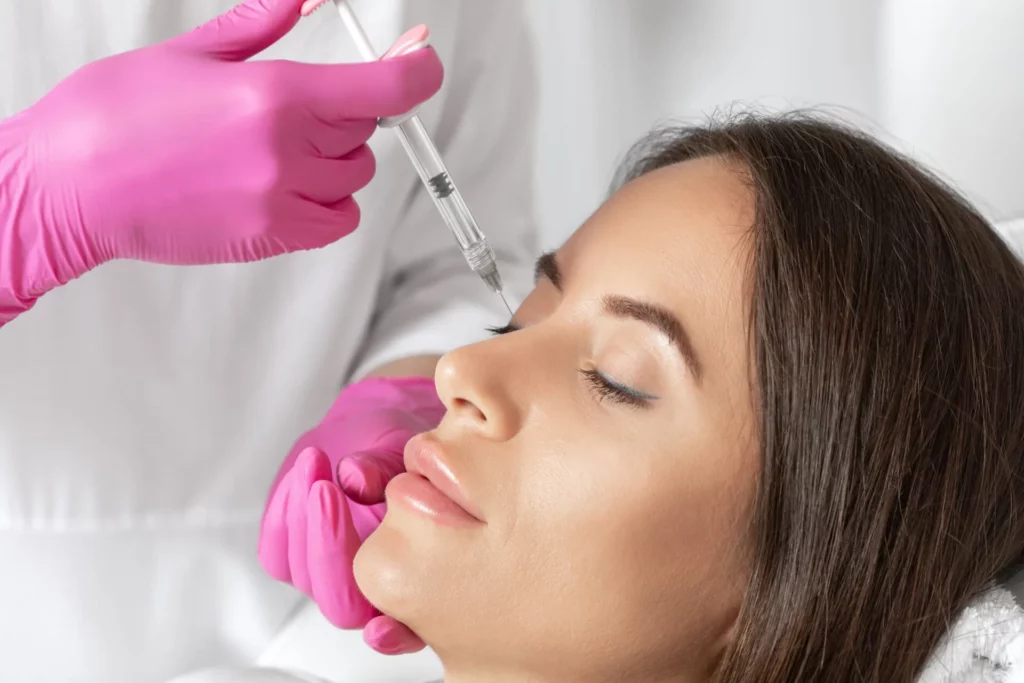What Is A Liquid Rhinoplasty?

Types of Dermal Fillers Used in Liquid Rhinoplasty
Hyaluronic Acid (HA) Fillers
Hyaluronic acid-based fillers are the most commonly used injectables for liquid rhinoplasty, prized for their versatility and reversibility. These gel-like substances naturally occur in the body, making allergic reactions rare. Products like Juvederm and Restylane are precisely injected to camouflage bumps, refine the nasal tip, or elevate a drooping nose. HA fillers typically last 6-12 months and can be dissolved with hyaluronidase if results are unsatisfactory. Many patients choose this treatment specifically to create facial balance, as it allows practitioners to make subtle adjustments that harmonize the nose with other features.
Calcium Hydroxylapatite (CaHA) Fillers
Calcium hydroxylapatite fillers, such as Radiesse, offer a thicker consistency and longer-lasting results for nonsurgical rhinoplasty. They typically maintain their shape for 12-18 months. CaHA is a mineral-like compound naturally found in human bones. It provides structural support while stimulating collagen production. This dual action makes it particularly effective for significant nasal bridge augmentation or correction of more pronounced deformities. The semi-permanent nature of CaHA fillers makes them appealing to patients seeking longer-lasting results without committing to surgery, though practitioners must be highly skilled to ensure optimal outcomes.
Poly-L-Lactic Acid (PLLA) Fillers
Poly-l-lactic acid fillers, such as Sculptra, function differently from other dermal fillers by gradually stimulating the body’s collagen production rather than providing immediate volume. This biocompatible synthetic substance works subtly over time, typically requiring 2-3 treatment sessions spaced several weeks apart. A topical anesthetic is usually applied before injection to minimize discomfort during the procedure. PLLA fillers can last up to two years, making them one of the longer-term options for liquid rhinoplasty. They are particularly effective for patients seeking gradual, natural-looking improvements to nasal contours with results that develop progressively over several months.
Why Is Surgical Rhinoplasty Better Than the Liquid Technique?
Permanent Results
One of the most significant advantages of nose surgery is the permanence of improvements. Unlike the liquid rhinoplasty procedure, which typically lasts 6-18 months before the body naturally metabolizes the fillers, operative results are designed to last a lifetime. This means patients can enjoy their new nasal profile without worrying about scheduling regular touch-up appointments or watching their improvements gradually fade. The permanence also makes surgical rhinoplasty more cost-effective in the long run, despite the higher initial investment.
More Precise Reshaping
Can Reduce Nose Size
Corrects Structural Issues
Surgical rhinoplasty is uniquely equipped to address fundamental structural issues. Problems with the nasal tip, such as bulbousness, drooping, or lack of definition, can be comprehensively corrected through surgical techniques. These structural corrections aren’t just cosmetic — they resolve underlying anatomical problems that may have existed since birth or developed due to injury. The ability to restructure the foundational elements of the nose allows for transformative results that address both form and function.
Improves Breathing Function
While rhinoplasty is often motivated by cosmetic improvements, this operation offers significant functional benefits that a non-surgical nose job cannot provide. Traditional rhinoplasty can improve airflow and breathing quality by correcting a deviated septum, reducing turbinate size, or repairing internal valve collapse. This dual benefit of enhanced aesthetics and improved respiratory function represents a compelling advantage over liquid alternatives, which focus exclusively on appearance and can sometimes even worsen breathing issues by narrowing nasal passages.
No Need for Ongoing Maintenance
The one-and-done nature of surgical rhinoplasty eliminates the need for regular maintenance appointments, which are necessary for a liquid nose job. Patients can enjoy their results after the initial healing period without planning for repeat procedures every year or so. This freedom from ongoing treatments not only saves time and money but also spares people from repeatedly experiencing the discomfort, swelling, and bruising associated with injectable procedures. When considering long-term satisfaction, the convenience of a single surgery often outweighs the appeal of “no downtime” fillers.
Addresses Complex Deformities
Dr. Zarrabi Uses the Latest Technology to Provide an Excellent Rhinoplasty Experience
A nonsurgical nose job offers a convenient and effective option for individuals seeking subtle improvements to their nasal appearance without invasive procedures. However, traditional rhinoplasty performed by a board-certified plastic surgeon remains the gold standard for those desiring permanent, precise, and comprehensive changes. Whether you choose dermal fillers or opt for surgery, it is essential to consult with an experienced professional like Dr. Zarrabi, who utilizes the latest techniques and technology to deliver exceptional results and ensure a safe, comfortable experience tailored to your unique needs.
It is easy to schedule a consultation on our website for professional support and excellent treatment. Dr. Zarrabi is always happy to meet new patients and help them achieve their aesthetic goals with maximum safety and effectiveness.